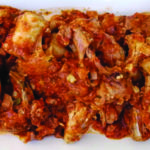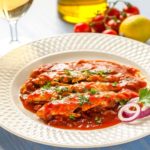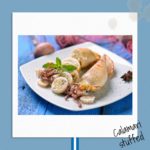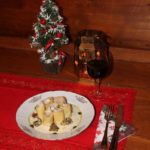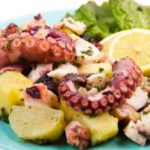STEWED GREEN BEANS

Green beans are an excellent fresh vegetable, but there are not many variations for their preparation. They are usually boiled and eaten accompanied by simple olive oil. But Italian creativity enriched a dull preparation with a touch of herbs and the beloved tomato, inventing a unique and tasty side dish, a symbol of summer and its fruits.
There are many versions of this dish: mine is the simplest, but an excellent one is using minced onion instead of garlic and adding chili pepper. Another version that is very popular in Tuscany, the land of meat-eaters where it is difficult to make vegetables appetizing for children, some grandmothers prefer preparing a soffritto with finely minced onion, celery, and carrot, and diced pancetta.
While up to few decades ago vegetables were boiled for an unnecessarily long time, or as my vegetarian brother complained, they were “tortured to death”, now we prefer crispy vegetables.
They are easy, quick to prepare, and impossible to get wrong, unless you abandon them in boiling water for hours. The result is a half-destroyed yellowish hay that not even a horse would eat.
Break off the top and wash them, leaving them whole. Today’s green beans have no strings, since only the fresh and best ones are harvested.
An excellent way to cook green beans and vegetables in general is to cook them in simmering water for 6 to 7 minutes (test them, they must be cooked but still al dente), and then immediately drained in a colander and plunged into ice cold water to bring the temperature down. A rule of thumb is that the beans should spend as much time in the cold water as in the hot water.
Prep Time: 5 minutes | Cooking Time: 20 minutes | Total Time: 25 minutes | Yield: Makes 4 servings.
Ingredients
- 2 tbsp fresh parsley, finely minced
- 500 g fresh green beans, washed
- 1 garlic clove, finely minced
- 3 tablespoons olive oil
- 1 tin crushed tomato or peeled plum tomatoes
Instructions
Preparation 1
Cook the green beans in simmering water for 6 to 7 minutes, immediately drain in a colander and plunge them into ice cold water to bring the temperature down.
In a deep pan (the one you use for sautéing pasta is ideal) sauté the garlic in the olive oil. Add the tomato sauce and cook for 10 minutes. When the tomato sauce has lost its acidity, season with salt and pepper and add the green beans and parsley.
Stir for 2 to 3 minutes and serve.
Preparation 2, the original
In a deep pan sauté the garlic in the olive oil. Add the tomato sauce, season with salt and pepper and add the green beans and parsley. Add water to cover the beans. Simmer for 10 minutes covered with a lid. Remove the lid and simmer for another 35 to 40 minutes, checking the green beans by tasting them, and if necessary, adding a bit more water.
This way of cooking them has the advantage of using less saucepans and bowls, and of course the green beans have more taste because they absorb the tomato sauce while cooking.
